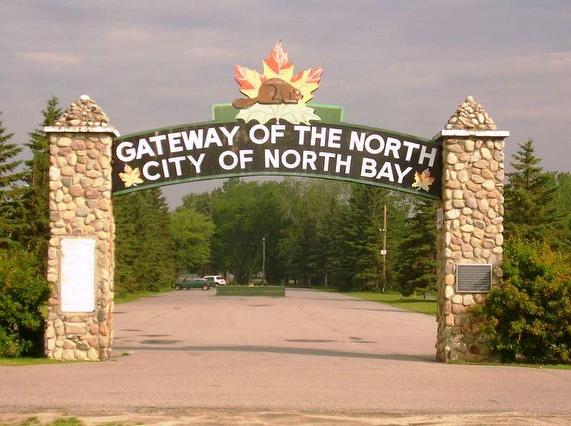
The site of North Bay was on the main canoe route west from Montreal. Apart from First Nations tribes, voyageurs and surveyors, there was little activity in the Lake Nipissing area until the arrival of the Canadian Pacific Railway in 1882. The CPR started its westward expansion from Callander Station (later renamed Bonfield), Ontario; Bonfield was inducted into Canadian Railway Hall of Fame in 2002 as the CPR First Spike location.
That was the point where the Canada Central Railway extension ended. The CCR was owned by Duncan McIntyre who amalgamated it with the CPR and became one of the handful of officers of the newly formed CPR. The CCR started in Brockville and extended to Pembroke. It then followed a westward route along the Ottawa River passing through places like Cobden, Deux-Rivières, and eventually to Mattawa at the confluence of the Mattawa and Ottawa Rivers. It then proceeded cross-country towards its final destination, Bonfield. Duncan McIntyre and his contractor James Worthington piloted the CCR expansion. Worthington continued on as the construction superintendent for the CPR past Bonfield. He remained with the CPR for about a year until he left the company. McIntyre was uncle to John Ferguson who staked out future North Bay after getting assurance from his uncle and Worthington that it would be the divisional and a location of some importance.
In 1882, John Ferguson decided that the north bay of Lake Nipissing was a promising spot for settlement. That year, the North Bay Police Service was also established. North Bay was incorporated as a town in 1891. The first mayor was John Bourke. More importantly, Bourke developed the western portion of North Bay after purchasing the interest of the Murray Brothers from Pembroke, who were large landholders in the new community. The land west of Klock Avenue (Algonquin Avenue) was known as the Murray block. Bourke Street is named after John Bourke. Murray Street is named after the Murrays.
Cementing North Bay's status as a railway town, it was selected as the southern terminus of the Temiskaming and Northern Ontario Railway (T&NO) in 1902 when the Ross government took the bold move to establish a development road to serve the Haileybury settlement. During construction of the T&NO, silver was discovered at Cobalt and started a mining frenzy in the northern part of the province that continued for many years. The Canadian Northern Railway was subsequently built to the town in 1913.
The Georgian Bay Canal was a mammoth transportation system that proposed to connect the Great Lakes with the Atlantic Ocean. The entire passageway from the Ottawa River to Lake Nipissing and down the French River to Georgian Bay was surveyed, mapped and ready to go in the first decade of the 20th century. Financing became the giant hurdle and as time passed, transportation patterns changed and interfered with the earlier practicality of the giant venture. Despite this, there were groups who still hoped it would happen as late as 1930.
North Bay grew through a strong lumbering sector, mining and the three railways in the early days. The town benefited from strong community leadership and people like Richardson, Milne, McNamara, Englands, Browning, McDougal, Carruthers, McGaughey, George W. Lee, Senator Gordon, T. J. Patton, Charlie Harrison, and many others are responsible for its development. In 1919, John Ferguson was elected mayor of North Bay and continued to serve as mayor until 1922. North Bay was incorporated as a city in August 1925.
The Dionne Quintuplets were born in Corbeil, Ontario, on the southern outskirts of North Bay in 1934. Their births had a tremendous impact on tourism in the area. In fact, the Dionnes may have saved the economy in the district during the Depression and beyond. North Bay and area lived off this legacy well into the 1960s. Many visitors to the area discovered lakes and summer retreats that were easily accessible and the businesses thrived on the tourist dollars.
In January 1968, the City of North Bay amalgamated with West Ferris and Widdifield townships.
During the Cold War, North Bay hosted a large Royal Canadian Air Force station at which were based Canadian and American North American Aerospace Defence Command forces. Although since the end of the Cold War the number of personnel and air units has been reduced greatly in size, the Canadian Air Force continues to maintain a presence at the base in the form of 22 Wing which is responsible for providing surveillance, identification, control and warning for the aerospace defence of Canada and North America. The United States Air Force also maintains 722 Air Control Squadron at the base. The long runways at North Bay have been maintained as an alternate landing site for Toronto's Pearson International Airport and were used during the September 11 crisis as an emergency landing site for several international aircraft.
The current engines driving North Bay's economy are the university and college population as well as the North Bay Regional Health Centre, newly opened in January 2011. Tourism, and a stable provincial government service centre also contribute to the robust economy.
On March 17, 2007, North Bay was announced as the winner of 2007 Kraft Hockeyville contest. North Bay received $50,000 to upgrade their local arena, Memorial Gardens, and also hosted an NHL pre-season game between the New York Islanders and the Atlanta Thrashers.
In 2009, multiple film productions came to the city, most notably The Kids in the Hall's 8-part TV miniseries for CBC Television, Death Comes to Town. North Bay's downtown, Memorial Gardens, and Trinity United Church were among the filming locations, as well as the neighbouring communities of Mattawa and Sturgeon Falls.
There is also a growing trend in post secondary students who decide to come to Canadore College and Nipissing University who wish for a quieter atmosphere than larger universities tend to have.
Copyright© 2026 Jumptools® Inc. Real Estate Websites for Agents and Brokers